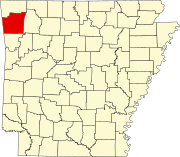Fayetteville, Arkansas
Fayetteville, Arkansas | |
|---|---|
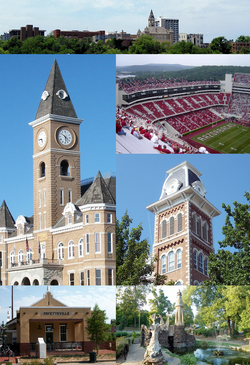 Clockwise from top: Fayetteville skyline, Donald W. Reynolds Razorback Stadium, Old Main, the Old Post Office, Fayetteville Depot, and the Washington County Courthouse. | |
| Nickname: "Track Capital of the World"[1] or "Fay" | |
| Motto: Regnat Populus (the people rule) | |
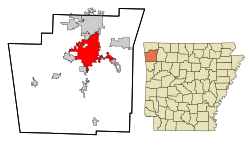 Location in Arkansas | |
| Country | United States |
| State | Arkansas |
| County | Washington |
| Incorporated | November 3, 1836 |
| Rechartered | 1867 |
| Named for | originally George Washington, renamed after Fayetteville, Tennessee |
| Government | |
| • Type | Mayor-City council |
| • Mayor | Lioneld Jordan |
| • City Council | Aldermen[2] |
| Area | |
| • City | 55.2 sq mi (143 km2) |
| • Land | 53.8 sq mi (139 km2) |
| • Water | 1.4 sq mi (4 km2) |
| Elevation | 1,400 ft (427 m) |
| Population | |
| • City | 75,102 |
| • Density | 1,366.3/sq mi (527.5/km2) |
| • Metro | 463,204 |
| Time zone | UTC-6 (Central) |
| • Summer (DST) | UTC-5 (Central) |
| ZIP codes | 72701-72704 |
| Area code | 479 |
| FIPS code | 05-23290 |
| GNIS feature ID | 0076914 |
| Website | http://www.accessfayetteville.org |
| U.S. Geological Survey Geographic Names Information System: Fayetteville, Arkansas | |
Fayetteville is the county seat of Washington County and the third-largest city in Arkansas. The city is centrally located within the county and is home to the University of Arkansas. Fayetteville is on the outskirts of the Boston Mountains, deep within The Ozarks. Known as Washington until 1829, the city was named after General Lafayette, a French general who helped the colonies gain freedom in the American Revolutionary War. It was incorporated on November 3, 1836 and was rechartered in 1867. The four-county Northwest Arkansas Metropolitan Statistical Area is ranked 109th in terms of population in the United States with 463,204 in 2010 according to the United States Census Bureau. The city had a population of 73,580 at the 2010 Census and 75,102 at the 2011 estimate.[5]
Fayetteville is deeply tied to the University of Arkansas, which is the flagship university in the state. Fall and spring bring thousands of students to campus which dramatically change the complexion of Fayetteville. As it is a Southeastern Conference institution, thousands of Arkansas Razorbacks fans go to Fayetteville for home football, basketball and baseball games. The University's track and field program has won 42 national championships to date.[6] Forbes ranked Fayetteville in 2010 as the 7th-best College Sports Town and 8th for Business and Careers.[7][8] Kiplinger's 2008 "Best Cities to Work, Live and Play" list featured Fayetteville as #7.[9] U.S. News ranked Fayetteville one of the best places to retire.[10] Based in nearby Bentonville, the Walmart corporation has contributed to the economy of Fayetteville. The city hosts the Wal-Mart Shareholders Meetings each year at Bud Walton Arena and is home to several of Walmart's corporate partners.
Forbes Magazine ranked the Fayetteville–Springdale–Rogers area as the second-best area in the United States for recovery from the current United States recession. Reasons cited were the presence of Walmart, one of the top Fortune 500 corporations, in the area, in addition to low unemployment (5.0%) compared to national averages.[11]
History
Settlement through Civil War

Washington County was created in 1828 and the county seat was located at the site of Fayetteville. The Washington Courthouse was built soon after, and also contained the post office. In 1829 Postmaster Larkin Newton changed the name to the Fayetteville Courthouse, to avoid confusing with Washington, Hempstead County.[12] Two councilmen selected to name the city were from Fayetteville, Tennessee, which was named for General Lafayette, a French general who helped the colonies gain independence in the American Revolutionary War.
The first store in Fayetteville was opened by John Nye in a small building constructed by James Holmsley. In 1832 David Walker, Chief Justice of the Arkansas supreme court, built a double log cabin on what is now Center Street. In 1822 Archibald Yell, the second Governor of Arkansas, built a house and called it "Waxhaw" after his home in North Carolina. This was on the outskirts of town then but now is a street named after him that connects College and School streets. The first hotels were the Burnside House and the Onstott House. Fayetteville was incorporated as a town on November 3, 1836.
In 1859 a city charter was obtained from the Legislature. During the Civil War the municipal government was suspended and was not reinstated until 1867. P.V. Rhea was the president of the town trustees in 1836; J.W. Walker was the first mayor under the charter of 1859, and M.L. Harrison was the first mayor when the government was reorganized in 1867.
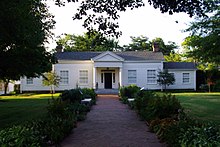
The telegraph came to Fayetteville in 1860, strung along the Military Road from Jefferson City, Missouri to Little Rock.[13] During the American Civil War, the Union General Benjamin McCulloch torched all non-essential buildings in Fayetteville in 1862, to reduce resources for Confederates. The following week, the Battle of Pea Ridge took place northeast of Fayetteville. The city housed wounded soldiers from the Battle of Prairie Grove in December 1862, and housed injured troops on Dickson Street.[14] Confederate troops besieged Union soldiers in Fayetteville on April 18, 1863 at the present-day intersection of College Avenue and Dickson Street, and at their headquarters.[13] Union soldiers held the city against cannon fire and cavalry attacks, although their headquarters sustained damage. The building was restored and is operated as the Headquarters House, a museum of the Washington County Historical Society.[15] Union forces repelled a Confederate attack in October 1864. After the war, the United States government established the Fayetteville National Cemetery in 1867. A cemetery for Confederate dead was founded in 1873.
Newspapers were established early; in 1859 Elias Cornelius Boudinot, a young European-Cherokee attorney, and James Pettigrew founded The Arkansan. The Fayetteville Weekly Democrat began publishing in 1868. It later developed as the Northwest Arkansas Times, and is still in print today.
The Fayetteville Schools District was founded on March 20, 1871 as the first independent school district in Arkansas. The public school system was established by the Reconstruction era legislature; before the war, all education was private.
Geography
...yet I venture the assertion that nowhere in said country—or for that matter, in any part of the state—could be found a lovelier elevation, or a lovelier grove of graceful oaks, or a more commanding view, or, in fine, a spot better suited and adapted for the purposes designated than the one chosen for said University [of Arkansas] site and farm.
—Noah Putnam Gates, first president of the University of Arkansas[16]
Topography

Fayetteville is located in the Boston Mountains, a subset of The Ozarks which run through northwest Arkansas, southern Missouri, and Eastern Oklahoma.[17] The Boston Mountains were formed when sediments were deposited on top of the Springfield Plateau during the Triassic period. In the Fayetteville area, the sediment was eroded to expose the old Springfield formation, while south of Fayetteville little erosion took place, forming the steep Boston Mountains. Fayetteville is also the namesake of the Fayetteville shale, a geological formation which has recently become an epicenter for natural gas extraction by hydraulic fracturing.[18]
According to the United States Census Bureau, the city has a total area of 55.2 square miles (143 km2), of which, 53.8 square miles (139 km2) of it is land and 1.4 square miles (3.6 km2) of it (2.59%) is water. The city is centrally located in Washington County, Arkansas along Interstate 540/US Route 71.Template:GR This is the only fully controlled access route through the area, which replaced the winding US 71 (now US 71B) in the 1990s.[19] An interstate connection with Fort Smith to the south and Kansas City, Missouri to the north has greatly helped to grow Fayetteville. Within Washington County, Fayetteville is bordered along the north by Springdale and Johnson. At times, this transition is seamlessly urban. Fayetteville is not bordered to its south, instead opening up to scenic country along the Boston Mountains Scenic Loop.[20] Past the communities of Greenland and West Fork is Devil's Den State Park.[19] To the west is Farmington along US Route 62 and to the east is undeveloped land in rural Washington County.[19]
Metropolitan area
The Fayetteville–Springdale–Rogers Metropolitan Area consists of three Arkansas counties: Benton, Madison, and Washington, and McDonald County, Missouri.[21] The area had a population of 347,045 at the 2000 census which had increased to 463,204 by the 2010 Census (an increase of 33.47 per cent). Although the Metropolitan Statistical Area does not consist of the usual principal-city-with-suburbs geography, Fayetteville's adjacent communities include Elkins, Farmington Greenland, Habberton, Johnson, and Wyman.
Districts within Fayetteville
| Fayetteville Experimental Station | ||||||||||||||||||||||||||||||||||||||||||||||||||||||||||||
|---|---|---|---|---|---|---|---|---|---|---|---|---|---|---|---|---|---|---|---|---|---|---|---|---|---|---|---|---|---|---|---|---|---|---|---|---|---|---|---|---|---|---|---|---|---|---|---|---|---|---|---|---|---|---|---|---|---|---|---|---|
| Climate chart (explanation) | ||||||||||||||||||||||||||||||||||||||||||||||||||||||||||||
| ||||||||||||||||||||||||||||||||||||||||||||||||||||||||||||
| ||||||||||||||||||||||||||||||||||||||||||||||||||||||||||||

Fayetteville is entirely contained within Fayetteville Township, as the township and city have identical boundaries. Although Arkansas generally does not use its civil townships for any governmental purpose, they are used for voting boundaries in some places.
Generally the parts of Fayetteville west of I-540/US 71 is called west Fayetteville. Another prominent district is Uptown Fayetteville, which encompasses the scores of business and new homes near the Northwest Arkansas Mall in north Fayetteville. The University of Arkansas defines its own part of Fayetteville, with dozens of student apartments and restaurants located near campus. The University's impact is also apparent along College Avenue, which contains hundreds of shops and restaurants. Northeast of campus are the Wilson Park Historic District and the Mount Nord Historic District. The Fayetteville Historic Square is the original city center of Fayetteville, and Dickson Street is the best-known entertainment district in Arkansas. Homes atop Mount Sequoyah in the eastern part of the city encircle Mount Sequoyah Retreat and Conference Center. Old structures are also located along the former Butterfield Overland Mail route, a stagecoach route to San Francisco, California now known as Old Wire Road. Fifteenth Street forms the southernmost residential district of Fayetteville, with the Fayetteville Industrial Park to its east.
Former unincorporated communities
Fayetteville has annexed four unincorporated communities and two historical unincorporated communities within its current corporate limits. The communities of Baldwin, Fayette Junction, McNair, and White Rock remain listed as existing "neighborhoods" according to the United States Geological Survey's Board on Geographic Names. These were absorbed as the city has expanded outward from its original plat. Two more communities, Barbara and Rucker's Grove have been removed and are now listed as historic unincorporated communities. None of the communities are recognizable or useful except as a historical reference.
Climate
Fayetteville lies in the humid subtropical climate zone (Köppen Cfa) with influence from the humid continental climate type. Fayetteville experiences all four seasons and does receive cold air masses from the north, however some of the Arctic masses are blocked by the higher elevations of the Ozarks. Fayetteville's Drake Field often records the coldest night temperatures in the state due to its high Ozarks valley location.
July is the hottest month of the year, with an average high of 89.1 °F (31.7 °C) and an average low of 68.6 °F (20.3 °C). Temperatures above 100 °F (37.8 °C) are rare but not uncommon, occurring on average twice a year. January is the coldest month with an average high of 44.3 °F (6.8 °C) and an average low of 24.2 °F (−4.3 °C). Highs below 32 °F (0.0 °C) occur on average thirteen times a year, with 2.2 nights per year dropping below 0 °F (−17.8 °C). The city's highest temperature was 111 °F (43.9 °C), recorded on July 14, 1954. The lowest temperature recorded was −24 °F (−31.1 °C), on February 12, 1899.
| Climate data for Fayetteville, Arkansas (1981-2010 normals) | |||||||||||||
|---|---|---|---|---|---|---|---|---|---|---|---|---|---|
| Month | Jan | Feb | Mar | Apr | May | Jun | Jul | Aug | Sep | Oct | Nov | Dec | Year |
| Record high °F (°C) | 76 (24) |
86 (30) |
96 (36) |
96 (36) |
95 (35) |
104 (40) |
111 (44) |
109 (43) |
105 (41) |
96 (36) |
90 (32) |
78 (26) |
111 (44) |
| Mean daily maximum °F (°C) | 46.2 (7.9) |
50.4 (10.2) |
59.1 (15.1) |
68.7 (20.4) |
75.5 (24.2) |
83.5 (28.6) |
88.7 (31.5) |
89.4 (31.9) |
80.8 (27.1) |
70.3 (21.3) |
59.2 (15.1) |
48.0 (8.9) |
68.3 (20.2) |
| Mean daily minimum °F (°C) | 26.1 (−3.3) |
29.0 (−1.7) |
37.8 (3.2) |
46.9 (8.3) |
55.7 (13.2) |
64.1 (17.8) |
68.7 (20.4) |
67.7 (19.8) |
58.9 (14.9) |
47.6 (8.7) |
39.2 (4.0) |
28.1 (−2.2) |
47.5 (8.6) |
| Record low °F (°C) | −23 (−31) |
−24 (−31) |
−11 (−24) |
18 (−8) |
28 (−2) |
41 (5) |
48 (9) |
44 (7) |
29 (−2) |
17 (−8) |
5 (−15) |
−12 (−24) |
−24 (−31) |
| Average precipitation inches (mm) | 1.99 (51) |
2.43 (62) |
3.54 (90) |
4.05 (103) |
4.99 (127) |
4.59 (117) |
3.18 (81) |
2.75 (70) |
4.43 (113) |
3.83 (97) |
4.19 (106) |
2.73 (69) |
42.70 (1,085) |
| Average snowfall inches (cm) | 1.6 (4.1) |
2.0 (5.1) |
0 (0) |
0 (0) |
0 (0) |
0 (0) |
0 (0) |
0 (0) |
0 (0) |
0 (0) |
0 (0) |
.7 (1.8) |
4.4 (11) |
| Average precipitation days (≥ 0.01 in) | 5.4 | 6.6 | 8.2 | 9.0 | 11.2 | 8.9 | 7.0 | 6.4 | 7.6 | 7.9 | 7.0 | 6.3 | 91.4 |
| Average snowy days (≥ 0.1 in) | .7 | .9 | 0 | 0 | 0 | 0 | 0 | 0 | 0 | 0 | 0 | .5 | 2.3 |
| Source 1: NOAA [22] | |||||||||||||
| Source 2: The Weather Channel[23] | |||||||||||||
Demographics
| Census | Pop. | Note | %± |
|---|---|---|---|
| 1840 | 425 | — | |
| 1850 | 508 | 19.5% | |
| 1860 | 972 | 91.3% | |
| 1870 | 955 | −1.7% | |
| 1880 | 1,788 | 87.2% | |
| 1890 | 2,942 | 64.5% | |
| 1900 | 4,061 | 38.0% | |
| 1910 | 4,471 | 10.1% | |
| 1920 | 5,362 | 19.9% | |
| 1930 | 7,394 | 37.9% | |
| 1940 | 8,212 | 11.1% | |
| 1950 | 17,071 | 107.9% | |
| 1960 | 20,274 | 18.8% | |
| 1970 | 30,729 | 51.6% | |
| 1980 | 36,608 | 19.1% | |
| 1990 | 42,099 | 15.0% | |
| 2000 | 58,047 | 37.9% | |
| 2010 | 73,580 | 26.8% |
In the 2010 census, Fayetteville had a population of 73,580 and grew by 26.8 percent from the year 2000.[24]
As of the census of 2010, there were 73,580 people, 33,661 households, and 14,574 families residing in the city. The population density was 1,333.0 people per square mile (514.0/km²). There were 38,281 housing units at an average density of 693.5 per square mile (267.4/km²). The racial makeup of the city was 83.8% White, 6.0% Black or African American, 1.1% Native American, 3.1% Asian, 0.2% Pacific Islander, 2.8% from other races, and 3.1% from two or more races. 6.4% of the population were Hispanic or Latino of any race.
Fayetteville was the second best educated city in Arkansas (after Maumelle) in the 2010 Census, proportionately, with 50.5% of adults age 25 or older holding an associate degree or higher, and 42.6% of adults possessing a bachelor's degree or higher.
There were 33,661 households out of which 19.9% had children under the age of 18 living with them, 31.4% were married couples living together, 7.1% had a female householder with no husband present, and 58.7% were non-families. 45.2% of all households were made up of individuals and 7.1% had someone living alone who was 65 years of age or older. The average household size was 2.04 and the average family size was 3.02.
In the city the population was spread out with 16.9% under the age of 18, 23.6% from 18 to 24, 31.5% from 25 to 44, 19.3% from 45 to 64, and 8.4% who were 65 years of age or older. The median age was 27.8 years. For every 100 females there were 100.9 males.
The median income for a household in the city was $34,393, and the median income for a family was $72,258. Males had a median income of $48,004 versus $36,373 for females. The per capita income for the city was $26,267. 23.7% of the population and 11.9% of families were below the poverty line. Out of the total population, 16.0% of those under the age of 18 and 5.3% of those 65 and older were living below the poverty line.[24]
49.6% of Fayetteville's population describes themselves as religious, slightly above the national average of 48.34%.[25] 50.8% of people in Fayetteville who describe themselves as having a religion are Baptist (25.22% of the city's total population). 15.5% of people holding a religion are Catholic (7.7% of the city's total population). There are also higher proportions of Methodists and Pentecostals above the national average.[25]
Economy
| 2010 Rank |
Employer | 2001 Rank |
|---|---|---|
| 1 | University of Arkansas | 1 |
| 2 | Washington Regional Medical Center | 3 |
| 3 | Veterans Administration Medical | 5 |
| 4 | Washington County Government | 7 |
| 5 | Fayetteville School District | 4 |
| 6 | Superior Industries | 2 |
| 7 | City of Fayetteville | 6 |
| 8 | Arvest Bank | 9 |
| 9 | Ayrshire Electronics | 10 |
| 10 | Arkansas Western Gas | 8 |
Although much of the Fayetteville–Springdale–Rogers Metropolitan Area has grown with Walmart's ascent to the #1 corporation listed by the Fortune 500, Fayetteville has often made it clear that the city prefers to associate itself with the University of Arkansas rather than the worldwide retailer. Walmart is based in nearby Bentonville, Arkansas and is one of four Fortune 500 corporations based in the state (the others being Dillard's, Murphy Oil, and Tyson Foods).[27] Tyson Foods in based in Springdale, Arkansas, which is adjacent to the north of Fayetteville. Despite not being based in Fayetteville, these corporations have a big impact through the University. The Sam M. Walton College of Business (named for Sam Walton) at the University of Arkansas has received numerous donations from the Walton family. Tyson also has a presence on campus at the Tyson Center for Excellence in Poultry Science which holds classes for the Dale Bumpers College of Agricultural, Food and Life Sciences. The poultry science program at Arkansas is one of the top three in the United States.[28] Transportation company J. B. Hunt is based in Lowell, Arkansas and has donated millions of dollars to the logistics program at the university, including $10 million funding the J.B. Hunt Center for Academic Excellence that completed in 2010.[29]
The University of Arkansas has also been changing into a research-centered university since the late-20th century. The university's stated goals now include becoming the economic engine for the region, the state of Arkansas, and beyond. This focus on innovation has helped draw students interested in research to Fayetteville. The university took a big step towards its new focus in 2010 when it was designated as a "very high activity research university" by the Carnegie Foundation for the Advancement of Teaching.[30][31]
In 2012, Forbes magazine ranked the City of Fayetteville #15 on its list of "Best Places For Business And Careers," using criteria such as the cost of doing business, cost of living, educational achievement, and crime rate.[32] In 2010 it was named #3 by Inc. Magazine on a list of "best mid-size cities for doing business".[33]
Culture, contemporary life, and points of interest

University of Arkansas
The University of Arkansas is Fayetteville's biggest attraction, with influence in the social, economic and educational avenues of Fayetteville.[34] The flagship university in the state, the U of A has become integrated with Fayetteville and vice versa. The University of Arkansas Campus Historic District listed on the National Register of Historic Places contains 71 acres (29 ha) and 25 buildings within a park-like arboretum.[34] In autumn, thousands of parents travel to Fayetteville to help their children move in to the various residence halls and apartments in the area, with thousands more attending Razorback football home games. Fans return for basketball games to pack Bud Walton Arena, which was the fifth-largest on-campus arena upon completion.[35] In spring the Hogs baseball team can be seen in Baum Stadium, named the top college baseball facility in the nation by Rivals.com in 2010.[36] No matter the season alumni and visitors are drawn to wander the campus in search of special names on Senior Walk, which is a 5-mile (8.0 km) sidewalk record of every graduate from the University of Arkansas, and the only sidewalk of its kind in the world.
Dickson Street

Dickson Street is the primary entertainment district in the region, including musical and stage performances, shopping, bars and restaurants. The West Dickson Street Commercial Historic District includes several blocks along it's namesake street as well as a few blocks of West Avenue lined with unique shops, restaurants and bars. Adjacent to the University of Arkansas campus, several of Dickson Street's establishments cater to students. The district has been enjoying a rejuvenation began in the 1980s by Dickson Street merchants who had watched the street turn into a dilapidated, crime-filled area. Many businesses had relocated onto College Avenue, leaving Dickson Street empty and in disrepair. The improvements lured the Walton Arts Center, today Arkansas' premier center for arts and entertainment, to locate on Dickson Street, a decision that proved beneficial to both parties.[37]
The center is the result of a joint effort between the City of Fayetteville and the University of Arkansas to bring arts to the city. The center is located on Dickson Street halfway between the University and the town square. It currently features a full Broadway theatre season, arts camps, continuing education opportunities for teachers of the arts, University-sponsored performances in addition to serving as a host for community events. A considerable donation from the namesake Walton family assisted greatly in the construction of the building.
TheatreSquared, Northwest Arkansas's only year-round professional regional theatre, is located just off Dickson Street, with an annual audience of 18,000 patrons including 7,500 students reached through outreach programs. The theatre was recognized in 2011 by the American Theatre Wing as one of the nation's ten most promising emerging theatres.[38]
Bikes Blues and BBQ (BBB) has taken place annually on Dickson Street since its inception in 2000. The motorcycle rally benefits local charities and is scheduled for a fall weekend when the Razorbacks football team is not playing in Fayetteville. Although scheduled for four days, motorcycle enthusiasts will often come early and stay late, unofficially extending BBB into a weeklong event. During the event, motorcycles will form an impromptu parade down Dickson Street for onlookers. Musical performances and many other unofficial events also accompany BBB each year.
Fayetteville Square
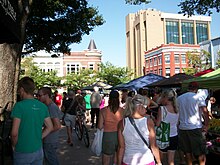
The Fayetteville Historic Square has been the center of Fayetteville since the county's first courthouse was located there in 1829. The area is surrounded by wide sidewalks, landscaped gardens, and one-way streets. The Square plays host to a variety of events, including First Thursday on the Square, the Block Street Block Party, the Lights of the Ozarks Festival and Fayetteville Farmer's Market. Containing boutiques, restaurants, music venues, museums, condos, the visitor center, and a convention center, the Square is constituted of both historic structures and new constructions.
The farmers' market began in 1974 and runs 7am to 1pm from the first Saturday in April through the last Saturday before Thanksgiving set in the Fayetteville Historic Square.[39] Over 60 vendors provide locally grown fruits and vegetables in addition to crafts, flower boquets, music and art, making the Fayetteville Farmers' Market very diverse. Upon receiving a grant in 2011, the Fayetteville Farmers' Market now accepts Electronic Benefit Transfer (EBT) and food stamps.[40] The market has been praised by the Farmers Market Coalition for its formatting which allows farmers to interact directly with customers and also empowering each vendor with a vote before making major changes in market policy.[40] The farmers' market moves to the Botanical Garden of the Ozarks for Sunday mornings with 20-30 vendors, with some vendors also choosing to attend the Mill District Farmer's Market on Thursday evenings.
The Fayetteville Public Library, founded in 1916, was relocated in October 2004 into a $23 million building, which was the first "green" building in Arkansas. The Blair Library was awarded the 2005 Thomson Gale Library Journal Library of the Year award, and, as a testament to its popularity, has seen its popularity increase dramatically, with three times more items checked out in 2005 than in 1997.[41] The library includes a local coffeeshop, Arsaga's, and hosts several events, including film festivals, book signings, and public forums throughout the year.
Historic districts and properties

Fayetteville contains 60 listings on the National Register of Historic Places (NRHP), the official federal list of districts, sites, buildings, structures, and objects deemed worthy of preservation. The University of Arkansas Campus Historic District constitutes the historic core of the UA campus. Residential historic districts with historically and architecturally significant contributions to Fayetteville include the Mount Nord Historic District, Washington-Willow Historic District, and Wilson Park Historic District. The Square is anchored by five NRHP structures; the original Fayetteville post office built in 1911, the Old Bank of Fayetteville Building, the Lewis Brothers Building constructed in 1908, the Mrs. Young Building built in 1887, and the Guisinger Building. The former Washington County Courthouse and Old Washington County Jail are located a few blocks east of the Square.
The Headquarters House served as a command post in the city for both the Union and Confederacy during the Civil War, and today serves as a museum. The Fayetteville National Cemetery is also listed on the NRHP. Built in 1867 following the Civil War, the cemetery has been expanded from its original 1,800 internments to over 7,000 internments.
Fayetteville was the first home of Bill and Hillary Clinton while they both taught law at the University of Arkansas School of Law. The house where they were married and lived is now the Clinton House Museum highlighting his early political life and features campaign memorabilia, a replica of Hillary's wedding dress, a photo gallery, and footage from his early campaign commercials.[42]
Parks and trail system


The Fayetteville Parks and Recreation Department maintains 70 parks whose total land area makes up 3,129 acres (1,266 ha).[43] The National Wildlife Federation has listed many parks and trails in Fayetteville as Certified Wildlife Habitats, which provide food, water, shelter, and a nurturing environment for young wildlife.[44] A favorite park in Fayetteville is Wilson Park, which anchors the Wilson Park Historic District.[45] The park was the city's first, and today contains a swimming pool, two playgrounds, a baseball field, picnic areas, and a 1981 castle in addition to courts for volleyball, basketball and tennis. The National Register of Historic Places-listed historic district encompasses 47 homes constructed in the late 19th and early 20th century along the southern edge of the park.[46]
A new addition to the Fayetteville parks scene is the Botanical Garden of the Ozarks. First envisioned in 1993, the Botanical Garden Society of the Ozarks raised funds for the facility until beginning construction in 2003. Planned to be built in three stages, the first stage will be completed near the end of 2011. The initial stages call for a visitor center, cafe, and garden gateway. Stage one also includes ⅓ of the total planned gardens and ½ the maintenance facilities.
Fayetteville takes pride in its trail system, and was named a bicycle friendly community by the League of American Bicyclists in 2010.[47][48] Trails in Fayetteville are well-marked with signs along the route in addition to road crossings. The city maintains trails within the city limits and segments of inter-city trails such as the future Razorback Greenway. The Razorback Greenway is a planned trail that will connect Fayetteville with Bella Vista (a distance of 34 miles (55 km)) via Johnson, Springdale, Lowell, Bentonville, and Rogers.[49]
The Fayetteville trail system is anchored by the Scull Creek Trail, a north–south paved trail which is 3.93 miles (6.32 km) in length and 12 feet (3.7 m) wide.[50] It crosses the namesake creek six times on arching steel bridges and also uses a 650 feet (200 m) tunnel, at one time the only pedestrian tunnel in Arkansas.[51] A trail of 3.7 miles (6.0 km) named the Dickson Street/U of A loop links around the campus of the University of Arkansas and ends at the corner of Dickson Street and College Avenue.[51] The Fayetteville Master Plan includes provisions for over 100 miles (160 km) of multi-use trails in the city. Approximately 2 to 3 miles (3.2 to 4.8 km) are added to the system per year.[52]
Government

Mayor–city council
Fayetteville operates within the mayor-city council form of government. The mayor is elected by a city-wide election to serve as the Chief Executive Officer (CEO) of the city by presiding over all city functions, policies, rules and laws. Once elected, the mayor also allocates duties to city employees. The Fayetteville mayoral election in coincidance with the election of the President of the United States. Mayors serve four-year terms and can serve unlimited terms.[53] The city council consists of eight aldermen who together form the legislative body for the city. Also included in the council's duties is balancing the city's budget and passing ordinances. The body also controls the representatives of specialized city commissions underneath their jurisdiction. Two aldermen are electeted from each of the city's four wards.[54]
Citizen boards, commissions, and committees
Citizen input is welcomed through the use of various specalized groups. Although some positions are appointed by the mayor, many consist of volunteers. Requirements include the applicant is a resident of Fayetteville and submission of an application in order to gain access to any of Fayetteville's 28 city boards. These range from appointed positions at the Northwest Arkansas Regional Planning Commission to the Fayetteville Arts Council to the Fayetteville Public Library Board of Trustees to the Historic District Commission and the Tree and Landscape Advisory Committee.[55]
Education

Fayetteville is served by the Fayetteville Public Schools system, which consists of eight elementary schools, four intermediate schools, two special schools, and Fayetteville High School. The district was established in 1871 as the oldest school district in Arkansas. Fayetteville High School has been recognized by Newsweek as one of America's top high schools based on Advanced Placement (AP) courses as well as AP test scores.[56] The school's student literary magazine and athletics programs have also received national praise.[57]
The University of Arkansas was founded in Fayetteville in 1871 as Arkansas Industrial University. The land-grant/space-grant, high-activity research institution is the flagship campus of the University of Arkansas System.[58] Enrollment for the 2010 fall semester was 21,406 total students.[59] Approximately 67% are Arkansas natives, with about 6% being international students.[60] Although it offers over 200 degree choices (excluding doctorate fields), the university is noted for its strong architecture, history, creative writing, poultry science, and business programs. Because of the University of Arkansas' large presence in many aspects of the city's economy, culture, and lifestyle, Fayetteville is often portrayed as a college town.[61]
Sports
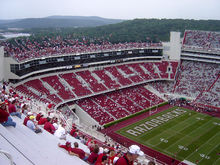
Fayetteville does not host any professional sports teams, allowing the Arkansas Razorbacks to control the sports scene. The Razorbacks (sometimes shortened to Hogs) are frequently referred to as "the state of Arkansas's professional team".[62] The Razorbacks compete in the National Collegiate Athletic Association's Division I and the Southeastern Conference.[63]
Donald W. Reynolds Razorback Stadium plays host to the Arkansas Razorbacks football team, usually hosting 5–6 home football games each season. Two more games are scheduled yearly at War Memorial Stadium in Little Rock, Arkansas, although there has been discussion of moving these games to Fayetteville in recent years. Some major high school football games in the state are played in Razorback Stadium as well. Bud Walton Arena is home to the Arkansas men's and women's basketball teams in addition to the Razorbacks gymnastics team. This facility was built in 1993 and holds 19,368 patrons. Arkansas volleyball plays in Barnhill Arena, also on the campus of the University of Arkansas. The Arkansas Razorbacks baseball team plays in Baum Stadium at George Cole Field, the nation's premier college baseball facility.[36] Softball plays in the newly built Bogle Park on campus.
Due to the success of Arkansas's track and cross country teams, Fayetteville is sometimes called the "Track Capital of the World".[64] The city has hosted the National Collegiate Athletic Association (NCAA) Division I Indoor Track and Field Championships at the Randal Tyson Track Center, one of the world's fastest surfaces. Arkansas also has hosted the Outdoor Track and Field Championships track facility at John McDonnell Field, named the top outdoor track and field facility of the year by the American Sports Builders Association in 2008.
The Blessings golf course is a golf course located along Clear Creek in Fayetteville. designed by Robert Trent Jones, Jr., it is said to be one of the most difficult golf courses in the U.S. The course is home to the University of Arkansas Razorbacks golf teams.
Media
The Fayetteville market is defined by Washington and Benton Counties and is also called the Northwest Arkansas market by Arbitron.[65] This two-county area was ranked 127th in the nation with a listening/viewing population (age 12+) of 356,900 as of Spring 2011.[66]
Radio
Cumulus Media owns seven stations in the Northwest Arkansas market, KFAY 1030 AM (news talk), KYNG 1590 AM, KQSM-FM 92.1 FM (ESPN radio), KAMO-FM 94.3 FM (classic country music), KRMW 94.9 FM, KKEG 98.3 FM (classic rock), and KMCK-FM 105.7 FM (Top 40). Clear Channel Communications owns four radio stations in the area, including KIGL 93.3 FM (classic rock), KMXF 101.9 FM (Top 40), KKIX 103.9 FM (country music) and KEZA 107.9 FM (adult contemporary). Butler Communications owns KXNA 104.9 FM (new rock), KREB 1190 AM, and KFFK 1930 AM. Two stations are operated by the University of Arkansas, KXUA 88.3 FM, which is a semi-automated, student-run station and KUAF, 91.3 FM, a national public radio (NPR) station. Kerm, Inc. operates two News Talk Information stations: KURM 790 AM and KLTK 1140 AM. KSEC 95.7 broadcasts in the Mexican Regional format and KFFK 1390 AM of Butler Communications broadcasts in the Spanish News/Talk format. Religious stations include KAYH 89.3 FM, KBNV 90.1 FM, and KLRC 101.1 FM. All sports radio station KUOA 1290 AM is rebroadcast on 105.3 in Fayetteville and features Arkansas Razorbacks coverage. KISR 95.9 FM is translated to Fayetteville from Fort Smith. Smaller operations include KOFC 1250 AM (news talk information) and KBVA 106.5 FM (variety).
Local TV stations
- KAFT, channel 13, PBS
- KFSM, channel 5, CBS
- KFTA, channel 24, Fox
- KHOG, channel 29, ABC
- KNWA, channel 51, NBC
Local newspapers
Local online media
- Fayetteville Flyer - fayettevilleflyer.com
- Ozarks Unbound - ozarksunbound.com
Infrastructure
Transportation
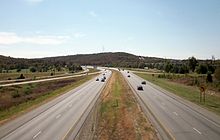
Major highways
The major through route in Fayetteville is Interstate 540/US 71. This fully controlled access, four-lane expressway is a spur route of Interstate 40, which is a cross-country route connecting California to North Carolina. I-540/US 71 became the first freeway in the area when it was completed in the 1990s to relieve the former US 71 (now US 71B) of a much-increased demand of through travellers following the unanticipated and rapid growth of the Northwest Arkansas metro. Future plans for the I-540/US 71 corridor include a redesignation as Interstate 49 upon completion of a freeway segment through Western Arkansas and the Bella Vista Bypass. When completed, I-49 will connect New Orleans, Louisiana to Kansas City, Missouri through Fayetteville.
Other major north–south routes in Fayetteville include US 71B, which was the predecessor to I-540/US 71. This route is now mostly designated College Avenue in Fayetteville and features dozens of restaurants and stores, with many aimed at the University of Arkansas student demographic. To the east of College Avenue is the oldest road in Fayetteville, Arkansas Highway 265. This route first was used by Native Americans as the Great Osage Trail, followed by Civil War troops bound for Fort Smith, Arkansas, the Trail of Tears, the Butterfield Overland Mail stagecoach route, and later still the telegraph. To the west of College Avenue is Gregg Avenue, which contains many student-oriented apartments along its shoulders and further west is Garland Avenue. This route runs along the campus of the University of Arkansas in south Fayetteville, with apartments and duplexes along its northern routing.
The city of Fayetteville has two major providers of public transportation. Razorback Transit is a free bus system centered around the campus of the University of Arkansas with routes to other Fayetteville destinations such as Dickson Street or the Northwest Arkansas Mall. Ozark Regional Transit runs throughout both Washington and Benton Counties and is a broader bus-based regional transit system.
Utilities
The City of Fayetteville owns and operates a large water system that provides services to several municipalities and unincorporated areas in the northern half of Washington County in addition to Fayetteville residents. Drinking water is pumped in from the Beaver Water District treatment plant in Lowell.[67] The city averages 14,000,000 US gallons (53,000,000 L) of water usage per day.[68] Fayetteville owns its own wastewater system, and operates nearby systems under contract. Treatment plants are located in the north, south, east, and west parts of town.
See also
References
- ^ "Solar Training Heads South to the Home of the Razorbacks in Fayetteville, Arkansas". January 28, 2011. Retrieved July 23, 2011.
- ^ Gill, Todd (December 18, 2012). "City Council recap for Dec. 18, 2012". Fayetteville Flyer.
{{cite web}}:|access-date=requires|url=(help); Missing or empty|url=(help) - ^ "U.S. Census Bureau Delivers Arkansas' 2010 Census Population Totals, Including First Look at Race and Hispanic Origin Data for Legislative Redistricting" (URL). United States Census Bureau. February 10, 2011. Retrieved July 23, 2011.
- ^ United States Census Bureau. "Profile of General Population and Housing Characteristics: 2010, 2010 Demographic Profile Data". Retrieved July 23, 2011.
- ^ "Table 3. Annual Estimates of the Resident Population for Incorporated Places in Arkansas: April 1, 2010 to July 1, 2011" (CSV). United States Census Bureau. April 1, 2010. Retrieved August 19, 2012.
- ^ University of Arkansas Track & Field site noting NCAA championships in Track and Field
- ^ Burke, Monte (2010). "In Depth: Top College Sports Towns". Forbes Magazine. Retrieved July 24, 2011.
- ^ "Best Places For Business And Careers". Forbes Magazine. 2007-04-05. Retrieved 2007-07-31.
- ^ Kiplinger.com. "2008 Best Cities".
- ^ Lagesse, David (September 20, 2007). "Best Places to Retire: Fayetteville, Arkansas". U.S. News. Retrieved July 30, 2011.
- ^ Zumbrun, Joshua (June 10, 2009). "In Pictures: The Best And Worst Cities For Recession Recovery". Forbes Magazine. Retrieved July 30, 2011.
- ^ Deane, Ernie (1986). Arkansas Place Names. Branson, Missouri: The Ozarks Mountaineer. p. 83. OCLC 14961821.
- ^ a b "Fayetteville History: 1860s" (Website). Fayetteville, AR. Retrieved July 10, 2011.
- ^ Wappel, Anthony J; Simpson, Ethel C (2008). Once Upon Dickson, An Illustrated History, 1868–2000 (First ed.). Fayetteville, AR: Phoenix International. p. 85. ISBN 978-0-9768007-7-4.
{{cite book}}:|format=requires|url=(help) - ^ "National Register of Historic Places". Little Rock, Arkansas: Arkansas Historical Preservation Program.
- ^ First Report of The Arkansas Industrial University. August 1873. p. 43.
{{cite book}}:|access-date=requires|url=(help) - ^ Branner, George C. (1984) [1940]. "Mineral Resources of Benton, Carroll, Madison, and Washington Counties". County Mineral Report 2. Little Rock, Arkansas: Arkansas State Geologist: 2.
- ^ "Fayetteville Shale: Map, News, Video". geology.com. Retrieved July 24, 2011.
- ^ a b c General Highway Map, Washington County, Arkansas (PDF) (Map). Cartography by Planning and Research Division. Arkansas State Highway and Transportation Department. December 22, 2011. Retrieved January 13, 2013.
- ^ Cox, Dale. "Boston Mountains Scenic Loop - Boston Mountains, Arkansas". Explore Southern History. Retrieved January 13, 2013.
- ^ "Update of Statistical Area Definitions and Guidance on Their Uses" (PDF). Executive office of the President Office of Management and Budget. December 1, 2009. p. 32. Retrieved January 13, 2013.
- ^ "NowData - NOAA Online Weather Data". National Oceanic and Atmospheric Administration. Retrieved 2012-02-15.
- ^ "Monthly Averages for Fayetteville, AR (72703)" (Table). The Weather Channel. Retrieved 2011-11-20.
- ^ a b Template:GR
- ^ a b Religion in Fayetteville, Arkansas
- ^ "Des Moines Statistical Section Table XVI" (PDF). City of Fayetteville, Arkansas. 2010. p. 120. Retrieved July 30, 2011.
- ^ "Fortune 500". Fortune Magazine. 2010.
{{cite web}}: Text "retrieved July 30, 2011" ignored (help) - ^ "Poultry Science Program Overview". Dale Bumpers College of Agricultural, Food and Life Sciences. Retrieved July 30, 2011.
- ^ "Securities and Exchange Commission Form 8-K, Current Report Pursuant to Section 13 or 15(d) of the Securities Exchange Act of 1934". J. B. Hunt Transport Services, Inc. October 13, 2005.
{{cite web}}:|access-date=requires|url=(help); Missing or empty|url=(help) - ^ "Search result for Very High Research Institutions". Carnegie Foundation for the Advancement of Teaching. Retrieved July 30, 2011.
- ^ "University of Arkansas Elevated to Highest Carnegie Classification Among U.S. Universities and Colleges". University of Arkansas. Retrieved July 30, 2011.
- ^ "Slide Show: The Best Places For Business And Careers". Forbes.
- ^ "The Top 20 Midsize Cities for Doing Business". Inc. Magazine. Retrieved July 30, 2011.
- ^ a b Glen Bennett, Rob Yallop, and Ralph S. Wilcox (May 20, 2009). "National Register of Historic Places Registration: University of Arkansas Campus Historic District" (PDF). National Park Service. p. 26. Retrieved 2001-08-18.
{{cite web}}: CS1 maint: multiple names: authors list (link) Cite error: The named reference "nrhpreg" was defined multiple times with different content (see the help page). - ^ Richardson, Steve (December 15, 1993). "New arena perfect backdrop for No. 1 Arkansas". Dallas Morning News.
- ^ a b Rogers, Kendall (October 28, 2008). "Rivals 10: College Baseball's Best Stadiums". Rivals.com. Retrieved 2011-08-18. Cite error: The named reference "rivals" was defined multiple times with different content (see the help page).
- ^ "Walton Arts Center: Mission and History". Walton Arts Center. Retrieved July 23, 2011.
- ^ "American Theatre Wing Recognizes 2011 National Theatre Company Grant Winners". TheaterManie. Retrieved February 12, 2012.
- ^ "Fayetteville Square Farmers Market". Local Harvest. June 10, 2010. Retrieved August 6, 2011.
- ^ a b "FMC Highlights Fayetteville Farmers Market". Fermers Market Coalition. August 4, 2011. Retrieved August 6, 2011.
- ^ "Fayetteville Public Library: History". Fayetteville Public Library. 2007. Retrieved 2007-07-31.
- ^ "Clinton House Museum". Retrieved July 3, 2011.
- ^ Map of Fayetteville Parks (PDF) (Map). Fayetteville Parks and Recreation Department. Retrieved August 2, 2011.
- ^ "Certify Your Wildlife Garden". National Wildlife Federation. Retrieved August 2, 2011.
- ^ "Wilson Park". City of Fayetteville. Retrieved August 2, 2011.
- ^ "Wilson Park and Mount Nord Historic Districts" (PDF). City of Fayetteville, Arkansas. Retrieved August 2, 2011.
- ^ Spencer, Christopher. "Fayetteville designated as a bicycle friendly community (Community Announcement)". Ozarks Unbound. Retrieved July 24, 2011.
- ^ "Current Bicycle Friendly Communities" (PDF). League of American Bicyclists. May 2011. Retrieved July 24, 2011.
- ^ "Northwest Arkansas Razorback Regional Greenway" (PDF). Northwest Arkansas Regional Planning Commission. June 2010. Retrieved July 24, 2011.
- ^ "Scull Creek Trail". City of Fayetteville, Arkansas. Retrieved July 24, 2011.
- ^ a b Trails Guide, Fayetteville, Arkansas (Brochure). City of Fayetteville, Arkansas. Retrieved July 24, 2011.
- ^ City of Fayetteville, AR Master Trail Plan (PDF) (Map). City of Fayetteville, Arkansas. September 1, 2009. Retrieved August 2, 2011.
- ^ "Fayetteville, Arkansas Mayor". City of Fayetteville.
{{cite web}}: Text "retrieved July 31, 2011" ignored (help) - ^ "Fayetteville, Arkansas City Council". City of Fayetteville.
{{cite web}}: Text "retrieved July 31, 2011" ignored (help) - ^ "Fayetteville, Arkansas City Clerk: Boards, Commissions and Committees". City of Fayetteville.
{{cite web}}: Text "retrieved July 31, 2011" ignored (help) - ^ "America's Best High Schools: The List". Newsweek. 2010. Retrieved August 3, 2011.
{{cite journal}}: Cite journal requires|journal=(help) - ^ "The 25 Best High School Athletic Programs". Sports Illustrated. February 8, 2010.
{{cite journal}}: Cite journal requires|journal=(help) - ^ "University of Arkansas". College Profiles. 2008. p. 21.
- ^ "Ark. Business online media newspaper Arkansas News ebusiness research journal". ArkansasBusiness.com. Retrieved January 24, 2011.
- ^ "Office of Institutional Research | University of Arkansas". University of Arkansas. Retrieved January 24, 2011.
- ^ "Best Places in USA: The Best Places to Live & Explore… For Every Lifestyle, Fayetteville: Arkansas". Best Places in USA. 2010. Retrieved August 3, 2011.
- ^ Low, Chris (April 11, 2011). "Hogs' Petrino eager to take next step". ESPN. Retrieved January 25, 2012.
- ^ "University of Arkansas, Fayetteville". National Collegiate Athletic Association. January 25, 2012.
{{cite web}}:|access-date=requires|url=(help); Missing or empty|url=(help) - ^ "Solar Training Heads South to the Home of the Razorbacks in Fayetteville, Arkansas". January 28, 2011. Retrieved January 25, 2012.
- ^ Arbitron. Arbitron Radio Metro Map Based on Fall 2011 Market Definitions (Map).
{{cite map}}:|access-date=requires|url=(help);|format=requires|url=(help); Text "http://www.arbitron.com/downloads/Arb_US_Metro_Map_11.pdf" ignored (help) - ^ "Arbitron Radio Market Rankings: Spring 2011". Arbitron. Retrieved 2011-08-18.
- ^ Pruna, Jocelyne (November 3, 2012). "Election Day Will Decide Two Positions for Beaver Water District". KFSM-TV. Retrieved January 13, 2013.
- ^ "Utilities Department". City of Fayetteville. Retrieved 2011-08-18.
External links
- City of Fayetteville
- 1908 Plat of Fayetteville
- Fayetteville Flyer
- NW Akansas Online
- NW Arkansas Times newspaper webpage (paid subscribers only)
- History of Fayetteville's Jewish community (from the Institute of Southern Jewish Life)
- Fayetteville Public Library
- Fayetteville History
- Encyclopedia of Arkansas History & Culture entry: Fayetteville (Washington County)


